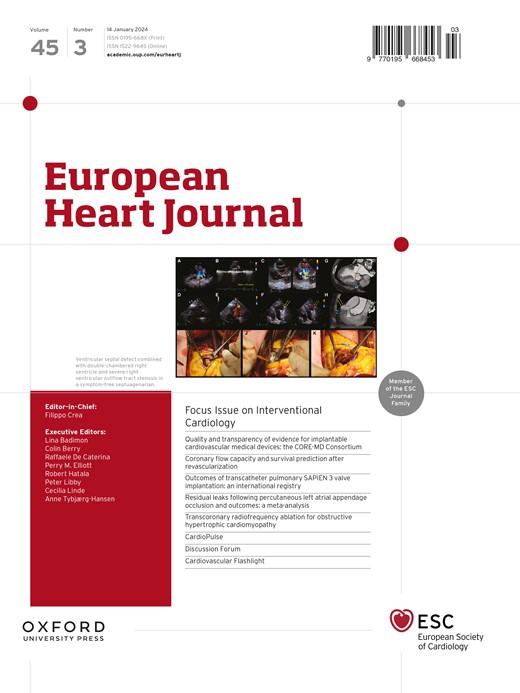Cardiologist follow-up and improved outcomes of heart failure: a French nationwide cohort
IF 37.6
1区 医学
Q1 CARDIAC & CARDIOVASCULAR SYSTEMS
引用次数: 0
Abstract
Background and Aims Outpatient cardiology follow-up is the cornerstone of heart failure (HF) management, requiring adaptation based on patient severity. However, risk stratification using administrative data is scarce, and the association between follow-up and prognosis according to patient risk has yet to be described at a population level. This study aimed to describe prognosis and management across different strata using simple criteria, including diuretic use and prior HF hospitalization (HFH). Methods This nationwide cohort included all French patients reported as having HF in the previous 5 years and alive on 1 January 2020. Patients were categorized into four groups: (i) HFH within the past year (HFH ≤ 1y), (ii) HFH 1–5 years ago (HFH > 1y), (iii) not hospitalized using loop diuretics (NoHFH/LD+), and (iv) not hospitalized without loop diuretics (NoHFH/LD−). Between-group associations, all-cause mortality (ACM), and cardiology follow-up were analysed using survival models. Results The study included 655 919 patients [80 years (70–87), 48% female]. One-year ACM risk was 15.9%, ranging from 8.0% (NoHFH/LD−) to 25.0% (HFH ≤ 1y). Mortality risk was 1.61-fold higher for NoHFH/LD+, 1.83-fold for HFH > 1y, and 2.32-fold for HFH ≤ 1y compared to NoHFH/LD− (P < .0001). During the first year of follow-up (2020), cardiology consultation rates were similar across groups, with 40% of patients lacking an annual visit. Compared to no consultation, a single cardiology visit in the previous year (2019) was associated with a 6%–9% absolute reduction in 1-year ACM during the following year (2020) across all groups. The number needed to consult (NNC) to prevent one modelled death was 11–16. Additional visits showed greater benefit with increasing HF severity, with NNC ranging from 55 (NoHFH/LD−) to 20 (HFH ≤ 1y). The optimal follow-up to minimize the number of deaths without increasing the total number of consultations was 1 annual visit for NoHFH/LD−, 2–3 visits for NoHFH/LD+ and HFH > 1y, and 4 visits for HFH ≤ 1y patients. Conclusions Despite having a HF diagnosis, 40% of patients do not see a cardiologist annually, regardless of disease severity. Simple stratification based on hospitalization history and diuretic use effectively predicts outcomes. Tailoring the annual number of HF consultations according to this stratification could optimize resource use and reduce avoidable modelled deaths.心脏病专家随访和心力衰竭的改善结果:法国全国队列
背景和目的心内科门诊随访是心衰(HF)管理的基石,需要根据患者的严重程度进行调整。然而,使用行政数据进行风险分层是稀缺的,并且根据患者风险进行随访与预后之间的关系尚未在人群水平上进行描述。本研究旨在用简单的标准,包括利尿剂使用和既往心衰住院(HFH),来描述不同人群的预后和治疗。方法:该全国性队列纳入了所有在过去5年内报告患有心衰且在2020年1月1日存活的法国患者。患者分为四组:(i)过去一年的HFH (HFH≤1y); (ii) 1-5年前的HFH (HFH >;1y), (iii)未住院使用环状利尿剂(NoHFH/LD+),以及(iv)未住院使用环状利尿剂(NoHFH/LD−)。使用生存模型分析组间关联、全因死亡率(ACM)和心脏病学随访。结果纳入655919例患者,年龄80岁(70 ~ 87岁),女性48%。1年ACM风险为15.9%,范围从8.0% (NoHFH/LD−)到25.0% (HFH≤1y)。NoHFH/LD+组死亡风险高1.61倍,HFH组高1.83倍;与NoHFH/LD - (P <)相比,HFH≤1y为2.32倍。。)。在随访的第一年(2020年),各组心脏病咨询率相似,40%的患者没有年度就诊。与没有咨询相比,前一年(2019年)一次心脏病学就诊与次年(2020年)1年ACM绝对减少6%-9%相关。预防一例模拟死亡所需咨询(NNC)的人数为11-16人。随着HF严重程度的增加,额外的就诊显示出更大的益处,NNC范围从55 (NoHFH/LD−)到20 (HFH≤1y)。在不增加总会诊次数的情况下,将死亡人数降至最低的最佳随访是:NoHFH/LD -患者每年就诊1次,NoHFH/LD+和HFH &;gt;HFH≤1y患者就诊4次。结论:尽管有心衰诊断,但无论疾病严重程度如何,40%的患者每年都不去看心脏病专家。基于住院史和利尿剂使用的简单分层有效预测预后。根据这种分层调整心衰咨询的年度数量可以优化资源利用并减少可避免的模拟死亡。
本文章由计算机程序翻译,如有差异,请以英文原文为准。
求助全文
约1分钟内获得全文
求助全文
来源期刊

European Heart Journal
医学-心血管系统
CiteScore
39.30
自引率
6.90%
发文量
3942
审稿时长
1 months
期刊介绍:
The European Heart Journal is a renowned international journal that focuses on cardiovascular medicine. It is published weekly and is the official journal of the European Society of Cardiology. This peer-reviewed journal is committed to publishing high-quality clinical and scientific material pertaining to all aspects of cardiovascular medicine. It covers a diverse range of topics including research findings, technical evaluations, and reviews. Moreover, the journal serves as a platform for the exchange of information and discussions on various aspects of cardiovascular medicine, including educational matters.
In addition to original papers on cardiovascular medicine and surgery, the European Heart Journal also presents reviews, clinical perspectives, ESC Guidelines, and editorial articles that highlight recent advancements in cardiology. Additionally, the journal actively encourages readers to share their thoughts and opinions through correspondence.
 求助内容:
求助内容: 应助结果提醒方式:
应助结果提醒方式:


